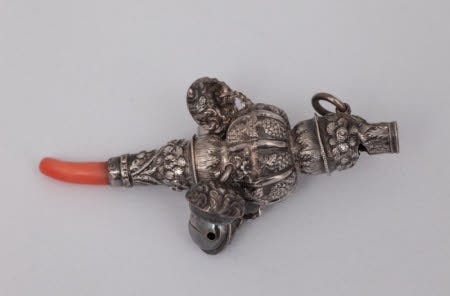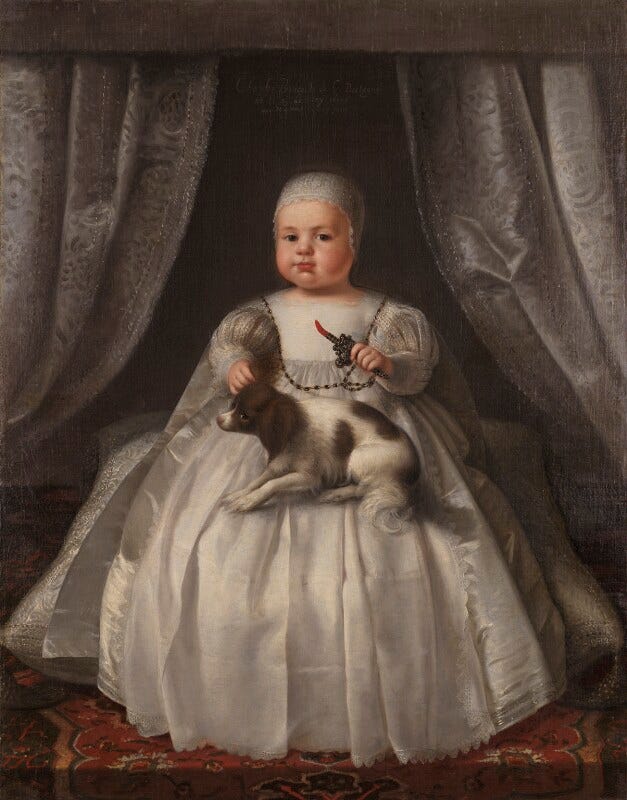Victorian Teethers Were Made from WHAT?
How did babies not poke themselves in the eye, like all the time?
A challenge of writing historical fiction is that it’s easy to look down on people who lived two centuries ago. Differences in technology or mindset sometimes make people seem so…ignorant. I have to remind myself to approach the past like a different culture, with the same respectful curiosity I would use when relating to someone of a different country.
This happened, for example, when I learned about the objects British people gave their small children to help with teething in the 1860s and 1870s.

I was working on a scene in which a mother is trying to comfort her crying infant. She’s in a remote outpost of South America, but she’s a recent British transplant. So she reaches for… I had to pause and write myself a note to fill in the blank with research later. What did Victorians use as baby teethers?
Turns out those who could afford it used a coral teething stick set in sterling silver. Bells were attached to the middle section, so it could also function as a rattle. The end opposite the coral had a whistle to help distract the baby from their pain and to scare away evil spirits. The teether was often worn as a necklace or tied around the child’s waist.

Apparently, coral was a popular item to use for babies from the time of the ancient Greeks and Romans until the late nineteenth century, when mother-of-pearl and ivory1 became more popular. Coral was considered to have protective properties that would help ward off evil and keep children safe from disease (and lightning).
When I first heard coral, I pictured the colorful reefs at my family’s favorite snorkeling spot when I was a high schooler in Panama: the living organisms that look porous and spongy but are sharp enough to slice your skin if you brush against them.2 The coral used in the teethers was similar but a particularly prized variety that keeps its pale pink, red, or red-orange color even after the living organisms die. It’s naturally smooth and is polished until shiny.
Considered an organic gemstone, coral is softer than mineral stones, and it doesn’t chip or splinter like wood or animal bones. It stayed cool against baby’s gums. So maybe it wasn’t a terrible choice of material for a teether.
But kids without developed motor skills surely must have poked themselves in the face and eye with the stick all the time. And how often did they swallow or choke on those little round bells?

These teethers were status symbols, so it’s possible children were mostly given the fancy silver ones for special occasions, like a christening or the painting of a portrait. They were popular as christening gifts, and they became family heirlooms, passed down from generation to generation. But they were definitely used by babies, at least to some degree: the ones in museums today (or sold at antique auctions) often have teeth marks, cracks in the silver, or missing bells.
Of course, this is only what the wealthy could afford. Parents who weren’t well-off used vegetables like carrots, dried bread crusts, wax candles, or their own fingers.
It was also common for people to give babies “teething syrups,” which contained opium, laudanum (morphine mixed with alcohol), or brandy. That stopped the crying and put the babies to sleep. For working-class mothers who needed to keep their job, it was essential that their babies sleep as much as possible, but doctors even at the time spoke out against drugging infants.

In the 1800s, there was a lot of fear related to teething. So many childhood illnesses killed babies in their first two years of life that teething was assumed to be the cause. The clear discomfort caused by hardening gums and emerging teeth was thought to upset the child’s digestive and nervous systems, leading to high fevers and deadly disease.
In 1842, 12% of London deaths of children under the age of four were attributed to teething.3 One highly-lauded French handbook said that one in six children died from “the accidents of dentition.”4 In 1893, a paper published in the Journal of the American Medical Association said, “So deadly has [teething] become, that one-third of the human family die before the twenty deciduous teeth have fully appeared. Its danger is constantly increasing.”5
One popular medical intervention to prevent death from teething was lancing the gums. (This was before the time of sterilization, which makes that even more horrifying.) Placing leeches on the gums was another solution.
It’s worth noting, though, that not all doctors at the time believed the same thing. In 1861, one doctor lamented, “I can assure you that the readiness to attribute all the diseases of infantile life to teething has destroyed more human beings than many of the wars described in history.”6
In such a context, you can imagine parents would be eager to give their teething children something that would not just distract them but protect them, as much as possible, against all the dangers and diseases that were rampant, whether caused by teething or not.
Even if babies poked themselves in the face from time to time.

Apparently, the whiteness of mother-of-pearl and ivory were associated with the purity of children. Ivory was also popular because it could be made into a ring, so kids wouldn’t stab themselves.
A friendly reminder for snorkelers: DON’T TOUCH THE CORAL. It may hurt you, but it kills the coral. The planet needs what few reefs we have left. Please and thank you.
According to the 1842 English Registrar-General Report, as cited in “It's Only Teething... A Report of the Myths and Modern Approaches to Teething.”
This is from A Treatise on First Dentition and the Frequently Serious Disorders which Depend on It, “a work crowned by the Royal Society of Medicine of Paris,” by Jean Baptiste Timothée Baumes, translated by Thomas Edison Bond and published in English in 1841. Cited in “The Trials of Teething: Soothing Infants in the Nineteenth Century.”
According to the abstract available here, cited (incorrectly) in “It's Only Teething... A Report of the Myths and Modern Approaches to Teething.”
As seen here, and cited in “Corals: Protection for Teething Babies.”




Quite interesting!